
Jelenia Góra valley
Encyclopedia
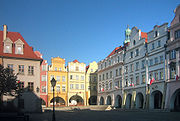
Western Sudetes
Western Sudetes are the Western part of Sudetes range system on the border of the Czech Republic, Poland and Germany. They stretch from the Bóbr river in the east to the Elbe and the Elbe Sandstone Mountains in the west....
and next to Kłodzko Valley the largest intramontane basin of the Sudetes. It is situated at an altitude of 250–400 meters above sea level and covers an area of 273 km2. In the 19th century, the lovely landscape attracted the Prussian high nobility, which built magnificent palaces, manors and parks. The enormous number of stately homes turned the valley into one of the most important garden landscapes in Middle Europe.
Geography
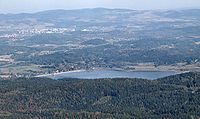
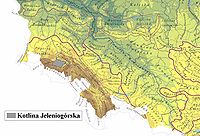
Karkonosze
Krkonoše is a mountain range located in the north of the Czech Republic and the south-west of Poland, part of the Sudetes mountain system . The Czech-Polish border, which divides the historic regions of Bohemia and Silesia, runs along the main ridge...
, which are also its southern limit. In the east it borders to Rudawy Janowickie
Rudawy Janowickie
The Rudawy Janowickie is a mountain range in Western Sudetes in Poland....
, in the west to the Iser Izery Mountains and in the north to the Kaczawskie Mountains
Kaczawskie Mountains
The Kaczawskie Mountains ) is a mountain range in Western Sudetes in Poland.* Length: 30 km* Average height: 600 m* Highest peak: Skopiec -External links:* * * ----wulkany, jaksinie, rzeźba, minerały, historia...
. The Bóbr
Bóbr
Bóbr is a river which runs through the north of the Czech Republic and the southwest of Poland, a left tributary of the Oder River, with a length of and a basin area of .The Bóbr originates in the Rýchory mountains in the southeast of the Karkonosze range, where the source is...
runs through the valley along its northern side, its tributaries Łomnica and Kamienna
Kamienna
Kamienna may refer to the following places in Poland:*Kamienna, Lower Silesian Voivodeship *Kamienna, Kuyavian-Pomeranian Voivodeship *Kamienna, Kutno County in Łódź Voivodeship...
flow, from the southeast and south-west, along the eastern and western side of the valley and open out near Hirschberg, since 1945 Jelenia Gora
Jelenia Góra
----Jelenia Góra is a city in Lower Silesia, south-western Poland. The name of the city means "deer mountain" in Polish, Czech and German. It is close to the Krkonoše mountain range running along the Polish-Czech border – ski resorts such as Karpacz and Szklarska Poręba can be found...
into the Bóbr. The name of the valley derives from Hirschberg (translated to Jelena Gora), which is also the most important town of the Silesian Karkonosze.
The valley is characterised by ridges which are separated by smaller basins. Wzgórza Karpnickie near Karpniki
Karpniki
Karpniki is a village in the administrative district of Gmina Mysłakowice, within Jelenia Góra County, Lower Silesian Voivodeship, in south-western Poland. Prior to 1945 it was in Germany. It lies approximately east of Mysłakowice, south-east of Jelenia Góra, and west of the regional capital...
is the easternmost ridge, followed by Obniżenie Mysłakowickie basin near Mysłakowice to the west, Wzgórza Łomnickie ridge to the southeast of Cieplice Śląskie Zdrój, the wide basin Obniżenie Sobieszowa near Sobieszów
Sobieszow
Sobieszów is a part of the town of Jelenia Góra in Poland.It is located near Karkonosze National Park. The ruined castle Chojnik is located in Sobieszów....
, Wysoczyzna Rybnicy ridge north west of Piechowice
Piechowice
Piechowice is a town in Jelenia Góra County, Lower Silesian Voivodeship, in south-western Poland. Prior to 1945 it was in Germany.It lies approximately south-west of Jelenia Góra, and west of the regional capital Wrocław....
and Starej Kamienicy basin near Stara Kamienica
Stara Kamienica
Stara Kamienica is a village in Jelenia Góra County, Lower Silesian Voivodeship, in south-western Poland. It is the seat of the administrative district called Gmina Stara Kamienica. Prior to 1945 it was in Germany....
.
History
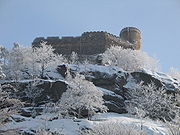
Bohemia
Bohemia is a historical region in central Europe, occupying the western two-thirds of the traditional Czech Lands. It is located in the contemporary Czech Republic with its capital in Prague...
near Jelenia Gora valley, such as Nowo Grodziec or Swiny. After Boleslaw I initiated the Ostsiedlung
Ostsiedlung
Ostsiedlung , also called German eastward expansion, was the medieval eastward migration and settlement of Germans from modern day western and central Germany into less-populated regions and countries of eastern Central Europe and Eastern Europe. The affected area roughly stretched from Slovenia...
in Silesia the valley was cleared of forests by German colonists beginning in the late 13th century, and several villages and towns were established, among them Hirschberg (now Jelenia Gora itself). During that time the family of Schaffgotsch, which later owned the entire valley until their expulsion
Flight and expulsion of Germans from Poland during and after World War II
The flight and expulsion of Germans from Poland was the largest of a series of flights and expulsions of Germans in Europe during and after World War II...
in 1945, also appeared for the first time in the region. After the forests lost its significance as a natural border against Bohemia the Silesian Piasts
Silesian Piasts
The Silesian Piasts were the oldest line of the Piast dynasty beginning with Władysław II the Exile, son of Bolesław III Wrymouth, Duke of Poland...
of the independent duchy Schweidnitz-Jauer (Świdnica-Jawor) built several castles in the valley to secure the border and to protect the new villages. Especially during the reign of Bolko II, who was in a constant feud with Bohemia, many fortifications were constructed.

Matthias Corvinus of Hungary
Matthias Corvinus , also called the Just in folk tales, was King of Hungary and Croatia from 1458, at the age of 14 until his death...
, who ruled over Silesia, destroyed almost all Silesian castles. During the Renaissance
Renaissance
The Renaissance was a cultural movement that spanned roughly the 14th to the 17th century, beginning in Italy in the Late Middle Ages and later spreading to the rest of Europe. The term is also used more loosely to refer to the historical era, but since the changes of the Renaissance were not...
and Baroque
Baroque
The Baroque is a period and the style that used exaggerated motion and clear, easily interpreted detail to produce drama, tension, exuberance, and grandeur in sculpture, painting, literature, dance, and music...
era many manors were expanded, sometimes to splendid palaces.
At the end of the 18th century artists and travellers attracted by the landscape discovered the valley. At first Bad Warmbrunn (Polish: Cieplice Śląskie-Zdrój) was the touristic center. In 1822 Wilhelm
Prince Wilhelm of Prussia
Prince Wilhelm of Prussia was the son of Frederick William II of Prussia and Frederika Louisa of Hesse-Darmstadt.- Life :...
, a brother of Prussian king William III
Frederick William III of Prussia
Frederick William III was king of Prussia from 1797 to 1840. He was in personal union the sovereign prince of the Principality of Neuchâtel .-Early life:...
, was the first prince of the Hohenzollern dynasty who took his summer residence in the Hirschberg valley. Later the king of Prussia itself bought Erdmannsdorf palace, which he had learned to appreciate in his previous visits. The valley became a princely hideaway. Many new parks were created and manors and palaces rebuilt according to the newest architectural styles. Artificial ruins, small pavilions, cottages, romantic temples and view points created a cultural landscape of international recognition.
At the end of the 19th century Hirschberg valley became one of the most favoured travel destinations in Germany. Tourism by car became popular after new streets, like the Sudetenstraße (Sudete road), were built in the first half of the 20th century. Many new hotels were constructed in Hirschberg, Krummhübel (Polish: Karpacz) and Schreiberhau (Polish: Szklarska Poreba), which also housed an artists' colony, and Bad Warmbrunn was one of the most popular spas in Eastern Germany. Palaces and parks became tourist attraction and many art collections were opened for the public.
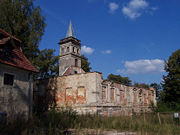
World War II
World War II, or the Second World War , was a global conflict lasting from 1939 to 1945, involving most of the world's nations—including all of the great powers—eventually forming two opposing military alliances: the Allies and the Axis...
Silesia was conquered by the Soviet Union
Soviet Union
The Soviet Union , officially the Union of Soviet Socialist Republics , was a constitutionally socialist state that existed in Eurasia between 1922 and 1991....
and the valley became part of Poland
Poland
Poland , officially the Republic of Poland , is a country in Central Europe bordered by Germany to the west; the Czech Republic and Slovakia to the south; Ukraine, Belarus and Lithuania to the east; and the Baltic Sea and Kaliningrad Oblast, a Russian exclave, to the north...
. The new owners rarely maintained the cultural heritage. Important churches and the castles, testimonies of the early Polish culture before the German colonization in the 13th and 14th century, were preserved, palaces and manors however were neglected, vandalized and sometimes removed. Directly after the war the reactivation of tourism was tried, however as most holiday homes in the valley were occupied by new settlers and the touristic infrastructure was in a sorry state these attempts failed. The parks, the excellent hiking trail network and erstwhile view points run to seed, while most of the art collections were either destroyed or dissolved and spread all over Poland.
After the collapse of communism in Poland a rediscovery of the cultural landscape began, which is increasingly accepted and appreciated by the descendants of the Polish settlers. Today many private and governmental initiatives as well as German expellee organisations and family members of former owners work together to revitalize the touristic infrastructure and cultural heritage, and academics work on the acceptance of the valley as a World Heritage Site
World Heritage Site
A UNESCO World Heritage Site is a place that is listed by the UNESCO as of special cultural or physical significance...
.
Parks
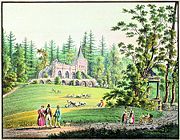
Sentimentalism
Sentimentalism is used in different ways:* Sentimentalism , a theory in moral epistemology concerning how one knows moral truths; also known as moral sense theory* Sentimentalism , a form of literary discourse...
, as the art of garden design was especially suitable to stimulate deep feelings like melancholy, teariness, amazement or joy.
In the course of the 19th century horticulture became more and more influenced by romantic
Romanticism
Romanticism was an artistic, literary and intellectual movement that originated in the second half of the 18th century in Europe, and gained strength in reaction to the Industrial Revolution...
ideas and a new historical awareness. Instead of different scenes and architectural styles more reduced designs, only consisting of mere scenic elements like trees, groves, creeks, meadows and hills, became popular. Extensive path networks and long viewshafts were a central element of these parks. A prominent example was the park of Fischbach.
The landscape architecture in Hirschberg valley culminated during the 1840s with the work of Peter Joseph Lenné
Peter Joseph Lenné
Peter Joseph Lenné was a Prussian gardener and landscape architect from Bonn who worked in the German classicist style.-Childhood and development:...
. New parks were created in Erdmannsdorf (Polish: Myslakowice), Schildau (Polish: Wojanow) and Lomnitz (Polish: Lomnica). These parks followed the so called zoned landscape garden, a principle which was adopted by Lenné and Pückler-Muskau from England. It was marked by richly decorated gardens around the house which were divided into small sections, followed by a pleasure ground as a transition zone and a landscape garden which faded into the proximity. The surrounding countryside was landscaped by Lenné with alleys, paths, lookout points and places to rest.
The large number of parks from different eras, the artistic reference of all these parks to the beautified surrounding countryside and the picturesque backdrop of the Giant Mountains created a unique landscape, which was regarded as a Silesian Elysium. Since a few years the Polish conservation organization tries to preserve and recreate the cultural landscape, which slowly recovers its lost beauty.
Sights
Jelenia Góra valley is the natural foreland of the Karkonosze. Many places in the valley offer unparalleled views of the mountains. An outstanding feature of the valley is the large number of country seats and locks, for example Mysłakowice, Staniszów and now to Jelenia Gora or Cieplice Śląskie-Zdrój with park and spa. Chojnik, a castle ruin on a foothill of the Karkonosze (Giant) Mountains, overlooks the entire Jelenia Góra valley.A lake district in the south of the Wzgórza Łomnickie at the foot of the mountains, created in the 1980s and 1990s, represents another distinctive feature. It consists of a series of dams, of which Zbiornik Sosnówka or Jezioro Sosnówka below Sosnówka
Sosnówka
Sosnówka may refer to the following villages in Poland:*Sosnówka, Biała Podlaska County in Lublin Voivodeship *Sosnówka, Jelenia Góra County in Lower Silesian Voivodeship...
and Podgórzyn
Podgórzyn
Podgórzyn may refer to the following places in Poland:*Podgórzyn, Lower Silesian Voivodeship *Podgórzyn, Kuyavian-Pomeranian Voivodeship *Podgórzyn, Warmian-Masurian Voivodeship...
, with a dam of 1.5 kilometres in length, 20 metres in height and an area of 170 hectares, is the largest.
Important castles, palaces and manors
For a complete list see List of castles and palaces in Jelenia Góra valleyWojanów palace
Wojanów palace , was one of three former royal Prussian summer residences in the valley. It was first mentioned in 1281. Since 1299 it was owned by family von Zedlitz. Between 1603 and 1607 Nikolaus Freiherr von Zedlitz und Nimmersatt erected a new building, which was destroyed during the Thirty Years' WarThirty Years' War
The Thirty Years' War was fought primarily in what is now Germany, and at various points involved most countries in Europe. It was one of the most destructive conflicts in European history....
and rebuilt in 1667 by Christoph von Zedlitz. Between 1832 and 1833 the interior of the palace was altered by a builder close to Karl Friedrich Schinkel
Karl Friedrich Schinkel
Karl Friedrich Schinkel was a Prussian architect, city planner, and painter who also designed furniture and stage sets. Schinkel was one of the most prominent architects of Germany and designed both neoclassical and neogothic buildings.-Biography:Schinkel was born in Neuruppin, Margraviate of...
. In 1839 Frederick William III of Prussia
Frederick William III of Prussia
Frederick William III was king of Prussia from 1797 to 1840. He was in personal union the sovereign prince of the Principality of Neuchâtel .-Early life:...
bought the building as a gift for his daughter Louise
Princess Louise of Prussia
Princess Louise of Prussia was the second child and only daughter of German Emperor Wilhelm I and Augusta of Saxe-Weimar-Eisenach. She was the younger sister of Frederick III of Germany and aunt of Wilhelm II of Germany...
. In the following years the park was newly designed by Peter Joseph Lenné
Peter Joseph Lenné
Peter Joseph Lenné was a Prussian gardener and landscape architect from Bonn who worked in the German classicist style.-Childhood and development:...
. After World War II
World War II
World War II, or the Second World War , was a global conflict lasting from 1939 to 1945, involving most of the world's nations—including all of the great powers—eventually forming two opposing military alliances: the Allies and the Axis...
the palace was looted and the furniture removed. The new Polish owners used it as a administrative building and holiday home. Later it was abandoned and fell into ruin. In 1995 a Polish-Italian company restored the building and it's surroundings, which now house a luxurious hotel, spa and a business centre. The park has been restored to its formal glory (Wojanow Palace home page).
Mysłakowice palace
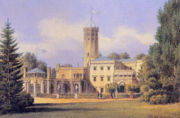
Richthofen
Richthofen is the surname of a prominent German aristocratic family. The most famous member is the air ace Manfred von Richthofen , also known as the "Red Baron", but a number of other members of his family are also notable for various reasons....
and August Neidhardt von Gneisenau. Gneisenau expanded it in neo-classical style. After his death Frederick William III of Prussia
Frederick William III of Prussia
Frederick William III was king of Prussia from 1797 to 1840. He was in personal union the sovereign prince of the Principality of Neuchâtel .-Early life:...
bought the palace and appointed Schinkel and Lenné to remodel palace and the park, which became one of the most beautiful landscape gardens in Silesia. In 1837 Frederick William III left large parts of his estate to religious refugees from Tyrol
County of Tyrol
The County of Tyrol, Princely County from 1504, was a State of the Holy Roman Empire, from 1814 a province of the Austrian Empire and from 1867 a Cisleithanian crown land of Austria-Hungary...
, who built picturesque Alpine styled houses. After Frederick Williams death his successor, Frederick William IV of Prussia
Frederick William IV of Prussia
|align=right|Upon his accession, he toned down the reactionary policies enacted by his father, easing press censorship and promising to enact a constitution at some point, but he refused to enact a popular legislative assembly, preferring to work with the aristocracy through "united committees" of...
, reconvert the palace to plans by Friedrich August Stüler
Friedrich August Stüler
Friedrich August Stüler was an influential Prussian architect and builder. His masterwork is the Neues Museum in Berlin, as well as the dome of the triumphal arch of the main portal of the Berliner Stadtschloss.-Life:...
in neo-Gothic style. Until 1909 the stately home continued to be the summer residence of the Prussians kings and German emperors, afterwards it was sold for 1,7 million Mark.
After Word War II the Communist Red Army
Red Army
The Workers' and Peasants' Red Army started out as the Soviet Union's revolutionary communist combat groups during the Russian Civil War of 1918-1922. It grew into the national army of the Soviet Union. By the 1930s the Red Army was among the largest armies in history.The "Red Army" name refers to...
occupied the palace. Since 1951 the Polish state used it as a school and largely destroyed the interior. Today parts of the exterior are renovated and most of the park is preserved, even though some important viewshafts are overgrown.
Karpniki palace
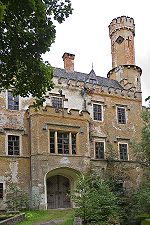
Prince Wilhelm of Prussia
Prince Wilhelm of Prussia was the son of Frederick William II of Prussia and Frederika Louisa of Hesse-Darmstadt.- Life :...
, is one of the best known palaces in the valley. It was first mentioned in 1364 as a moated castle, which was expanded in the 15th century. Initially owned by the families Predel and Reichenbach, it was bought by Hans I. Schoff in 1476, who enlarged the castle with a two storied mansion. After a fire in 1593 the building was again expanded with two new wings in Renaissance style. In 1822 prince Wilhelm acquired Fischbach, which became the first summer palace of the Hohenzollern dynasty in the valley. Beginning from 1844 it was reconstructed in neo-Gothic style according to plans in part by the prince himself. Wilhelm and his successors also equipped the palace with a remarkable art collection of medieval glass paintings and far eastern objects of art. At the end of World War II it was used as a depository for important art treasures from Silesia and the national library in Berlin.
After the war Russian and Polish soldiers plundered Karpniki, which became part of Poland. In the following years the palace was used as a school and a mental hospital. Over time it fell into disrepair and had to be evacuated. In the following years it was several times depredated and also willfully destroyed. After the fall of the Iron Curtain several initiatives tried to hold up the decline, until now however without success.
The large park of the estate was created after 1822 to instructions of princess Marianne. The arrangement referred to the family of the owners. A bench of marble showed medallions of the prince, the princess and its children, a neo-Gothic monument commemorated to a brother of princess Marianne and the Waldemarsturm housed a weapons collection of prince Waldemar. But also cottages, a greenhouse, a cross on the summit by Christian Daniel Rauch
Christian Daniel Rauch
Christian Daniel Rauch was a German sculptor. He founded the Berlin school of sculpture, and was the foremost German sculptor of the 19th century.-Biography:Rauch was born at Arolsen in the Principality of Waldeck...
and many other buildings and structures were erected.
Today the park is barely visible and most of its buildings are destroyed.
Bukowiec palace
Bukowiec palace - formerly Countess von Reden, now academy, with park und BelvedereCieplice Sląski Zdrój palace
Cieplice Sląski Zdrój palace - palace Count of SchaffgotschExternal links
- http://dolnyslask.org/sudety/kotjgora.html - description and pictures

